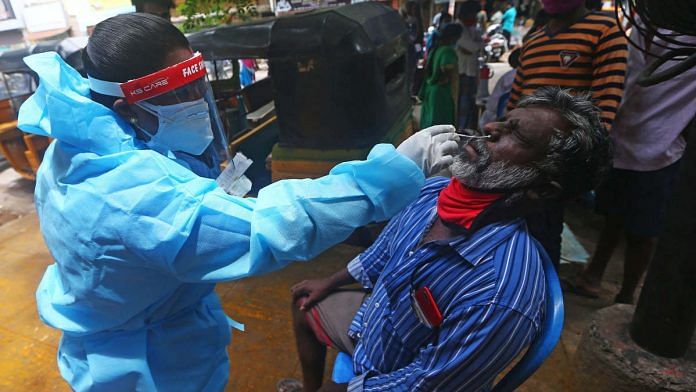New Delhi: Tamil Nadu and Andhra Pradesh have two of the most developed health systems in India, but Covid-19 patients in these states are being detected far too late compared to international standards.
A study by researchers at Princeton University’s Center for Disease Dynamics, Economics and Policy, the Johns Hopkins Bloomberg School of Public Health and other institutions — published in the journal Science — showed that in 18 per cent of cases in these two states, patients were diagnosed either less than 24 hours before death or posthumously. The study looked at cases recorded until 1 August.
Half of the cases ascertained before death in Tamil Nadu and Andhra Pradesh succumbed in under six days of testing, the study noted. It also found that 1,042 fatal cases (18.2 per cent of 5,733 observed) were identified within 24 hours before death or posthumously.
“Our estimates of time-to-death in Tamil Nadu and Andhra Pradesh are below what has been observed internationally: In the United States, median time-to-death from the date of hospital admission was 13 days, and the World Health Organization estimated time to death following onset of symptoms could range from two to eight weeks based on data from China,” it stated.
“Our observations likely indicate a substantial proportion of patients in Tamil Nadu and Andhra Pradesh are diagnosed late in their disease course, although differences in patients’ health status, healthcare systems capacity, and approaches to end-of-life care may also contribute to variation in time to death,” it added.
Also read: Covid transmission rate less than 1 in Andhra & Tamil Nadu, Maharashtra positivity rate spikes
Age-specific concentration
Deaths from coronavirus in India have been concentrated among people aged 50-64, which is slightly less than the 60-plus at-risk population in the United States, the researchers reported.
“Age-specific estimates ranged from 0.05 per cent (0.012-0.11 per cent) at ages 5-17 years to 16.6 per cent (13.4-19.9 per cent) at ages ≥85 years. Risk of death was higher among male cases than among female cases overall, and the magnitude of this difference widened in the oldest age groups. Higher mortality in older age groups and among males have similarly been observed in high-income settings,” the study stated.
The case fatality rate for the 18-29 years age group was 0.16 per cent. It went up to 0.50 per cent among 30-39-year-olds. Among 40-49-year-olds, it was 1.31 per cent, going up to 3.82 per cent among 50-64-year-olds, further up to 9.58 per cent among 65-74-year-olds, and amounting to 13 per cent among 75-84-year-olds, the study added.
Comorbidities
Reflecting India’s status as the diabetes capital of the world, the study found that diabetes was the most common comorbidity among patients who died of Covid-19 in Tamil Nadu and Andhra Pradesh.
“Among decedents in the two Indian states, the most prevalent comorbid conditions were diabetes (45.0 per cent), sustained hypertension (36.2 per cent), coronary artery disease (12.3 per cent), and renal disease (8.2 per cent),” the researchers said.
“While prevalence of any comorbidity was highest among decedents at older ages, this pattern differed across conditions; diabetes was most prevalent among decedents ages 50-64 years, and liver disease and renal disease were most prevalent in fatal cases at ages 0-17 years and 18-29 years, respectively. At least one comorbid condition was noted among 62.5 per cent of fatalities, in comparison to 22 per cent of fatalities in the United States as of 30 May 2020,” they noted.
Also read: Covid cases spread in rural Andhra & Telangana — blame big fat weddings and unlock
Children are disease transmitters
India’s Ministry of Home Affairs Wednesday issued new unlock guidelines that give states leeway to take a call on re-opening schools and educational institutions outside of containment zones. But the study struck a note of caution.
“While the role of children in transmission has been debated, we identify high prevalence of infection among children who were contacts of cases around their own age; this finding of enhanced infection risk among individuals exposed to similar-age cases was also apparent among adults,” the researchers stated.
“School closures and other non-pharmaceutical interventions during the study period may have contributed to reductions in contact among children. Nonetheless, our analyses suggest social interactions among children may be conducive to transmission in this setting,” they affirmed.
Lead researcher Ramanan Laxminarayan, a senior research scholar at the Princeton Environment Institute, said: “Kids are very efficient transmitters in this setting, which is something that hasn’t been firmly established in previous studies. We found that reported cases and deaths have been more concentrated in younger cohorts than we expected based on observations in higher-income countries.”
Children and young adults were much more likely to contract coronavirus from people their own age, the study found. Across all age groups, people had a greater chance of catching the coronavirus from someone their own age. The overall probability of catching coronavirus ranged from 4.7 per cent for low-risk contacts up to 10.7 per cent for high-risk contacts.
Super-spreaders the key culprits
The study also showed how super-spreaders have been instrumental in the spread of the disease in Tamil Nadu and Andhra Pradesh. The researchers found that 71 per cent of infected individuals did not infect any of their contacts, while a mere 8 per cent of infected individuals accounted for 60 per cent of new infections.
“Our study presents the largest empirical demonstration of super-spreading that we are aware of in any infectious disease. Super-spreading events are the rule rather than the exception when one is looking at the spread of Covid-19, both in India and likely in all affected places,” Laxminarayan said.
Also read: 20% of Andhra exposed to Covid, sero-survey finds, exposure highest where case tally lowest



